
Trout are a diverse group of fish, found in cold, freshwater environments around the world. These fish are not just beautiful; they are also highly specialized for life beneath the water’s surface. From their shimmering scales to their finely tuned sensory systems, every feature plays a role in their survival. Think of them as the ultimate water warriors, equipped with skills that help them navigate challenges, avoid predators, and hunt for food.
So, grab a cozy seat, and let’s explore the unique adaptations that allow trout to thrive underwater!
1. Streamlined Bodies
One of the first things you might notice about trout is their sleek, streamlined bodies. This design isn’t just for looks; it’s essential for swimming efficiently in fast-moving water. Much like a well-built sports car, a trout’s body shape reduces drag as it moves through the streams and rivers.
The narrow, elongated body allows trout to dart quickly to escape predators or chase after food. Imagine trying to swim through a crowded pool with bulky arm floaties—it would be tough! In contrast, a trout can twist and turn with ease, thanks to its hydrodynamic shape. This streamlined form is also complemented by powerful muscles that provide bursts of speed when they need to make a quick getaway.
Adaptation to Different Habitats
Trout come in various species, each adapted to specific environments. For example, stream-dwelling trout often have more elongated bodies compared to their lake counterparts, which might be a bit rounder. This variation helps them thrive in their unique habitats. Whether it’s racing through a river or gliding in still water, their body shapes are finely tuned for success.
2. Specialized Fins
Trout have a few types of fins, each serving a unique purpose. The most notable are the pectoral and tail fins. These fins are like a swimmer’s arms and legs, giving them the ability to steer, balance, and propel themselves through water.
The tail fin, or caudal fin, is particularly important. When a trout flicks its tail, it can make sharp turns or powerful bursts of speed, which is crucial when evading predators like eagles or larger fish. It’s almost like having a turbo boost when they need it most!
Stability and Maneuverability
The pectoral fins, located on the sides, provide stability and help trout maintain their position in fast currents. It’s like having training wheels when you’re learning to ride a bike. These fins work together to help trout navigate through rough waters, making them incredibly agile swimmers.
3. Keen Senses
Trout have some of the best senses in the animal kingdom, especially when it comes to detecting food and avoiding danger. Their eyes are positioned on the sides of their heads, providing a broad field of vision. This helps them spot predators from a distance and find prey lurking in the shadows.
But here’s where it gets really interesting: trout can also sense vibrations in the water through special cells along their bodies called lateral lines. These cells detect even the faintest movements, helping them locate prey like insects or smaller fish. It’s almost like having a built-in radar system!
Smell and Taste
Along with excellent vision, trout have a strong sense of smell. They can detect chemicals in the water from several feet away, which is helpful for finding food and navigating their environment. Just think, while we might be looking for scents in the kitchen, trout can sniff out a tasty meal from yards away!
4. Camouflage and Coloration
If you’ve ever seen a trout up close, you know they are stunningly colorful. Their scales can range from vibrant greens to deep reds and even browns. This beautiful coloration is more than just pretty; it’s a form of camouflage that helps them blend into their surroundings.
Trout often have darker backs and lighter bellies. This counter-shading helps them avoid predators by making them harder to spot from above and below. If a predator is swimming above, the trout’s dark back blends in with the murky water, while its lighter belly blends in with the sunlit surface.
Seasonal Changes
Interestingly, some species of trout can even change their color based on seasonal changes or their spawning behavior. During the breeding season, male trout often become more colorful to attract females. This splash of color isn’t just for show; it’s part of their mating strategy!
5. Temperature Regulation
Trout thrive in cold water, typically preferring temperatures between 50°F and 60°F. Their bodies are adapted to handle these chilly conditions, which can often mean the difference between life and death.
Trout are cold-blooded, meaning their body temperature matches that of their surroundings. This unique adaptation helps them conserve energy, especially when the water is freezing. Their metabolic rates slow down in colder waters, allowing them to survive in environments where other fish might struggle.
Finding the Right Habitat
Trout will often seek out spring-fed streams or deep pools where the temperature remains cooler throughout the summer. They are also known to migrate to different water sources as the seasons change, ensuring they stay in their ideal temperature range.
6. Diet and Feeding Strategies
Trout are opportunistic feeders, which means they’ll eat whatever is available and nutritious. Their diet can consist of small fish, insects, crustaceans, and even plant material at times. This flexibility in diet is a key adaptation that helps them thrive.
Their sharp teeth and strong jaws make it easier to catch slippery prey. But that isn’t the only strategy they use. Some trout will actually mimic the movements of their prey to lure them in—think of it as a clever game of cat and mouse.
Feeding Habits Throughout Life Stages
As trout grow, their feeding habits change. Young trout, or fry, often snack on small insects and zooplankton. As they mature, they begin to hunt for larger prey. This change in diet is crucial for their growth and survival, allowing them to utilize the resources available in their ecosystem effectively.
7. Reproductive Adaptations
Reproduction is a critical part of any species’ survival, and trout have unique adaptations for this. Most trout migrate upstream to spawn in freshwater, often returning to their birthplace. This journey can be perilous, but it’s essential for ensuring the next generation of trout.
During spawning season, males develop bright colors and engage in elaborate displays to attract females. Once a female chooses a mate, they will lay thousands of eggs in gravel nests called “redds.” The male then fertilizes them, and they’ll settle into the gravel, where they will develop away from predators.
Survival of the Young
The eggs and fry are vulnerable during their early life stages, which is why choosing the right spawning site is essential. The gravel bottom provides protection, while the current helps provide oxygen to the developing eggs. This strategy increases their chances of survival in a world full of hungry predators.
8. Social Behavior and Grouping
Trout aren’t just solitary creatures; they often exhibit social behavior that can enhance their survival. While some species prefer to live alone, others thrive in groups. This social structure can help in several ways, including increased protection from predators and more efficient feeding.
When trout are in schools, they can better react to threats. If a predator approaches, the fish can scatter in different directions, making it harder for the predator to catch one. It’s like a team working together to stay safe!
Territorial Behavior
Despite being social at times, trout can also be quite territorial. They mark their territory and defend it against rivals, especially during the spawning season. This behavior ensures they have access to resources and the best spawning sites, which are crucial for their reproductive success.
In conclusion, the adaptations that help trout thrive underwater are truly remarkable. From their streamlined bodies and keen senses to their beautiful coloration and social behaviors, each feature plays an essential role in their survival. Trout exemplify resilience and versatility in the aquatic world, proving they’re more than just pretty fish in the water. So, next time you see a trout, take a moment to appreciate the evolutionary wonders that make it an expert at thriving in its underwater habitat!

